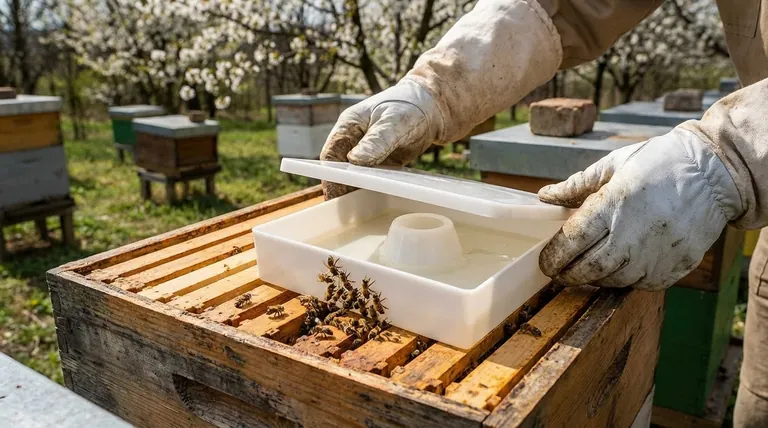In short, beekeepers feed bees sugar water because it is significantly safer and more economical than honey. While it seems counterintuitive, feeding bees honey—especially from an unknown source—can introduce deadly diseases and pathogens to a hive. Sugar water provides a clean, reliable, and inexpensive energy source to prevent starvation without this critical risk.
The decision to use sugar water over honey is a fundamental practice in responsible beekeeping. It prioritizes the health and biosecurity of the colony by eliminating the risk of disease transmission that is inherent in using honey from other hives.

Why Feeding a Colony Becomes Necessary
A beekeeper’s primary goal is to ensure a colony is self-sufficient. However, certain situations require intervention to prevent the colony from starving.
Late Winter and Early Spring
This is the most dangerous time for a honeybee colony. Their winter food stores are at their lowest, but the first spring flowers have not yet bloomed, creating a potential gap in their food supply.
Establishing a New Colony
A brand-new colony or a captured swarm has no honey reserves. Feeding is essential to provide the energy they need to build comb, raise young bees, and gather their first nectar stores.
A Sudden Nectar Dearth
Sometimes, extreme weather like a drought or a long, rainy spell can interrupt the natural nectar flow from flowers. Supplemental feeding helps the hive survive until conditions improve.
The Critical Risks of Using Honey as Feed
Using honey to feed bees presents significant, often unacceptable, risks to the entire colony.
Disease Transmission
Honey can contain dormant spores of devastating bee diseases, such as American Foulbrood. If a beekeeper feeds a colony honey from an infected hive, they can easily transmit the pathogen and wipe out their own bees.
The Danger of Unknown Honey
Store-bought honey is particularly risky. It is often a blend from many different sources, making its origin impossible to trace. It may carry pathogens or impurities that are harmless to humans but fatal to bees.
Prohibitive Cost
Honey is the valuable product beekeepers harvest. Using it as feed is economically unsustainable, as it requires feeding bees the very crop they are meant to produce.
Why Sugar Water is the Professional Standard
Sugar water (a simple solution of refined white sugar and water) has become the default choice for supplemental feeding for clear and practical reasons.
Guaranteed Safety and Purity
Unlike honey, refined sugar is a pure carbohydrate that is free of bee-specific pathogens. It provides a clean source of energy without any risk of introducing disease into the hive.
Complete Control and Consistency
Beekeepers can mix sugar water in different ratios for different purposes. A thin 1:1 ratio (sugar to water) mimics nectar and stimulates the queen to lay eggs, while a thick 2:1 ratio helps the bees build up their winter food stores.
Prevents Robbing
Feeding with honey can incite "robbing," where bees from neighboring hives smell the honey and attack the colony to steal its stores. Sugar water has a much weaker scent, making it less likely to trigger this destructive behavior.
Making the Right Choice for Colony Health
Ultimately, feeding is a tool for stewardship, used only when necessary to ensure the colony's survival and well-being.
- If your primary focus is emergency survival: Use sugar water to provide immediate energy when a colony's own stores are depleted, especially in late winter.
- If your primary focus is disease prevention: Never feed bees honey from another hive or from a store, as this is the most common way to introduce devastating pathogens.
- If your primary focus is long-term colony strength: Use feeding as a temporary support system while ensuring your bees have access to abundant natural pollen and nectar from diverse floral sources.
Responsible feeding is a cornerstone of beekeeping, ensuring a colony has the support it needs to thrive.
Summary Table:
| Feeding Option | Key Benefit | Main Risk |
|---|---|---|
| Sugar Water | Safe, pure energy source; Prevents disease | None when properly mixed |
| Honey | Natural food source | High risk of transmitting fatal diseases like American Foulbrood |
Ensure your apiary's health with the right supplies. HONESTBEE provides commercial apiaries and beekeeping equipment distributors with high-quality, wholesale-focused supplies—from feeders to protective gear—to support robust colony management. Contact our experts today to discuss your wholesale needs and build a healthier, more productive operation.
Visual Guide

Related Products
- HONESTBEE Professional Hive Top Bee Feeder Feeding Solution
- HONESTBEE Entrance Bee Feeder Professional Hive Nutrition Solution for Beekeeping
- Rapid Bee Feeder White Plastic 2L Round Top Feeder for 8 or 10-Frame Bee Hives
- Classic Boardman Entrance Bee Feeder Hive Front Feeding Solution
- HONESTBEE Round Hive Top Bee Feeder for Syrup
People Also Ask
- How do I keep bees from drowning in my top feeder? Ensure Safe Feeding for Your Hive
- Do I need an inner cover with a hive top feeder? Optimize Your Hive Setup for Healthy Bees
- What should be done with feeders and equipment after feeding bees? Essential Steps for Apiary Health
- What is the best way to top feed bees? A Safe, High-Volume Feeding Solution for Your Apiary
- What safety features are included in top feeders? A Guide to Drowning Prevention and Hive Safety



















